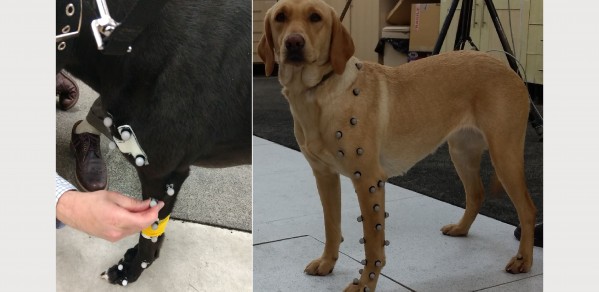
Dogs with diseased elbows may benefit from a new collaborative study between the Departments of Engineering and Veterinary Medicine.
If we can develop an engineering model that allows us to calculate the force on the elbow joint, then we can use it to diagnose elbow dysplasia sooner and potentially use it in the development of a more effective implant.
Professor Michael Sutcliffe
Using a technology which is most often seen on a movie set, the researchers are studying dogs with elbow dysplasia, a painful, debilitating and progressive inherited condition which affects a significant percentage of Labrador Retrievers and other popular dog breeds.
In this new work, researchers from the two Departments are using 3-dimensional motion capture techniques on healthy dogs in order to model the forces on their elbow joints as they move. Once normal patterns of movement have been established, they will be compared against results from dogs affected by elbow dysplasia. The results from the study are expected to provide new insights into the effects of the disease on joint function, potentially allowing for better staging of the disease and earlier intervention. Additionally, understanding how the normal joint functions will make it possible to develop new surgical implants that will improve joint function and reduce lameness in these dogs.
Elbow dysplasia is an inherited condition which has similarities with hip dysplasia in humans. Labradors and Rottweilers are especially prone to the condition, in which the cartilage surrounding the elbow joint starts to degrade. Without the cushioning that the cartilage provides, fragments of bone can break off as the bones of the elbow joint grind against each other, causing significant pain for the dog.
“It’s like a ticking time bomb – the first symptoms usually appear when the dogs are young, but they often get worse over time,” said Professor Matthew Allen of the Department of Veterinary Medicine. “The condition can be managed, but there isn’t a really effective treatment for it at the moment.”
Despite the fact that it is an inherited condition, there is currently no genetic test for elbow dysplasia. The condition can only be diagnosed after symptoms have appeared, when dogs have started to limp or otherwise modify their gait to cope with the pain, which can end up causing further damage to the joint.
“Right now, it difficult to diagnose the condition until it’s pretty serious,” said Professor Michael Sutcliffe from the Department of Engineering. “If we can develop an engineering model that allows us to calculate the force on the elbow joint, then we can use it to diagnose elbow dysplasia sooner and potentially use it in the development of a more effective implant.”
Currently, there are effective implants to replace hip joints in dogs, but replacing an elbow joint with an implant is far more difficult. Although current implants work reasonably well, dogs who have had an elbow joint replaced often struggle to return to full function after surgery.
“We’re trying to understand at a simple level how dogs with elbow dysplasia differ from normal dogs in the way they walk,” said Allen. “Our long-term goal is not to prevent the condition, but to treat it better. We want to intervene earlier so that we can give the dog a better quality of life.”
The researchers, including Sutcliffe’s fourth year students; Luke Johnson, Tom Broughton and Angus Bain, are using motion capture techniques to track the movements of the dogs. This data can then be used to develop mathematical models of the forces passing through normal and diseased joints. The models will be used to predict the success of current and novel surgical procedures, as well as to program a new robotic joint simulator that has recently been installed in the Surgical Discovery Centre in the Department of Veterinary Medicine.
“We want to be able to quantify the effects that elbow dysplasia has on the well-being of dogs,” said Allen. “We know that mobility is an issue, but we don’t really know what the effect is. It’s possible that this data will enable us to identify a tipping point where the condition goes from being manageable to being a problem.”
According to Allen, it’s possible that using the data he and Sutcliffe have collected, a better elbow implant could be available in the clinic in as little as three years.

